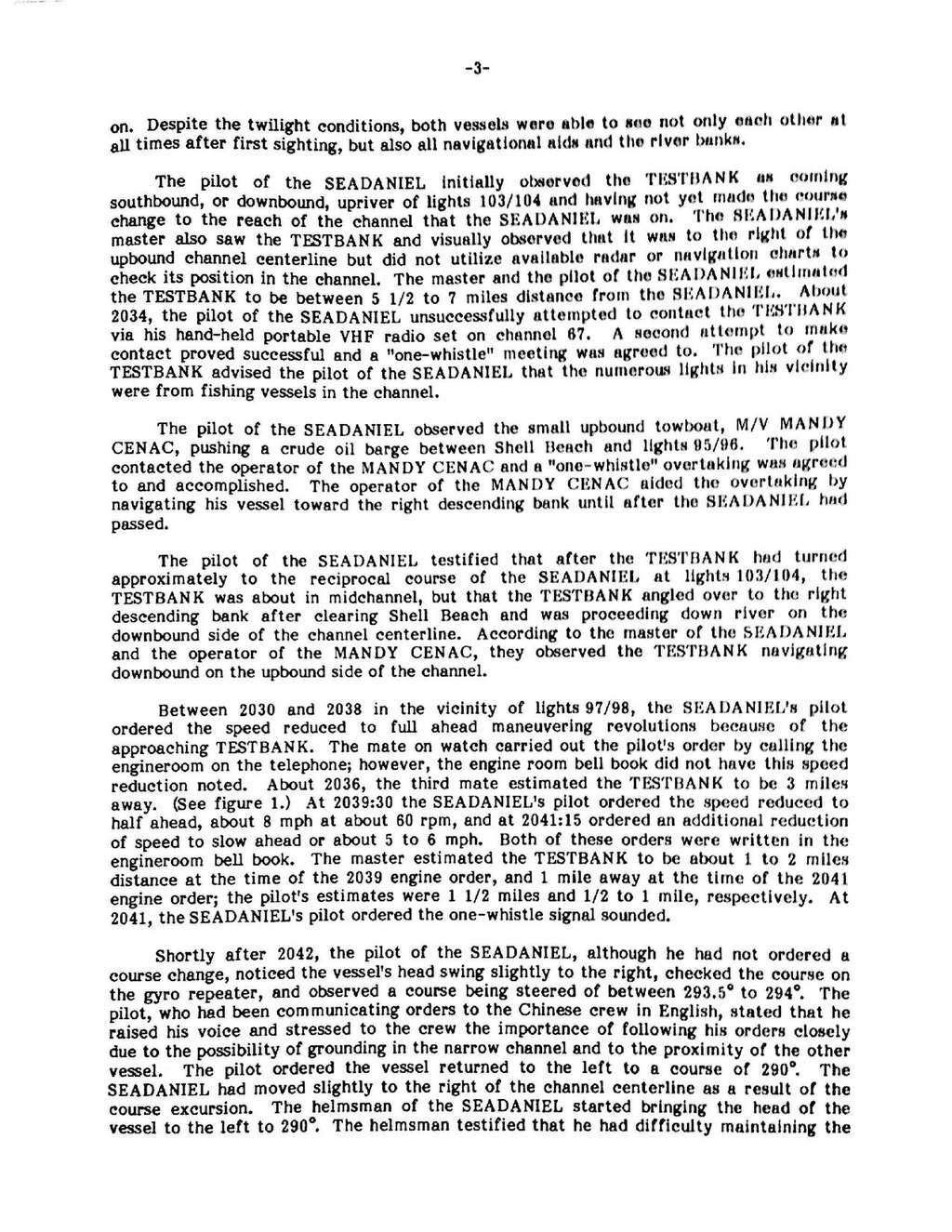on. Despite the twilight conditions, both vessels were able to see not only each other at all times after first sighting, but also all navigational aids and the river banks.
The pilot of the Seadaniel initially observed the Testbank as coming southbound, or downbound, upriver of lights 103/104 and having not yet made the course change to the reach of the channel that the Seadaniel was on. The Seadaniel's master also saw the Testbank and visually observed that it was to the right of the upbound channel centerline but did not utilize available radar or navigation charts to check its position in the channel. The master and pilot of the Seadaniel estimated the Testbank to be between 5 1/2 to 7 miles distance from the Seadaniel. About 2034, the pilot of the Seadaniel unsuccessfully attempted to contact the Testbank via his hand-held portable VHF radio set on channel 67. A second attempt to make contact proved successful and a "one-whistle" meeting was agreed to. The pilot of the Testbank advised the pilot of the Seadaniel that the numerous lights in his vicinity were from fishing vessels in the channel.
The pilot of the Seadaniel observed the small upbound towboat, M/V Mandy Cenac, pushing a crude oil barge between Shell Beach and lights 95/96. The pilot contacted the operator of the Mandy Cenac and a "one-whistle" overtaking was agreed to and accomplished. The operator of the Mandy Cenac aided the overtaking by navigating his vessel toward the right descending bank until after the Seadaniel had passed.
The pilot of the Seadaniel testified that after the Testbank had turned approximately to the reciprocal course of the Seadaniel at lights 103/104, the Testbank was about in midchannel, but that the Testbank angled over to the right descending bank after clearing Shell Beach and was proceeding down river on the downbound side of the channel centerline. According to the master of the Seadaniel and the operator of the Mandy Cenac, they observed the Testbank navigating downbound on the upbound side of the channel.
Between 2030 and 2038 in the vicinity of lights 97/98, the Seadaniel's pilot ordered the speed reduced to full ahead maneuvering revolutions because of the approaching Testbank. The mate on watch carried out the pilot's order by calling the engineroom on the telephone; however, the engine room bell book did not have this speed reduction noted. About 2036, the third mate estimated the Testbank to be 3 miles away. (See figure 1.) At 2039:30 the Seadaniel's pilot ordered the speed reduced to half ahead, about 8 mph at about 60 rpm, and at 2041:15 ordered an additional reduction of speed to slow ahead or about 5 to 6 mph. Both of these ordered were written in the engineroom bell book. The master estimated the Testbank to be about 1 to 2 miles distance at the time of the 2039 engine order, and 1 mile away at the time of the 2041 engine order; the pilot's estimates were 1 1/2 miles and 1/2 to 1 mile, respectively. At 2041, the Seadaniel's pilot ordered the one-whistle signal sounded.
Shortly after 2042, the pilot of the Seadaniel, although he had not ordered a course change, noticed the vessel's head swing slightly to the right, checked the course on the gyro repeater, and observed a course being steered of between 293.5º to 294º. The pilot, who had been communicating ordered to the Chinese crew in English, stated that he raised his voice and stressed the to the crew the importance of following his orders closely due to the possibility of grounding in the narrow channel and to the proximity of the other vessel. The pilot ordered the vessel returned to the left to a course of 290º. The Seadaniel had moved slightly to the right of the channel centerline as a result of the course excursion. The helmsman of the Seadaniel started bringing the head of the vessel to the left to 290º. The helmsman testified that he had difficulty maintaining the
